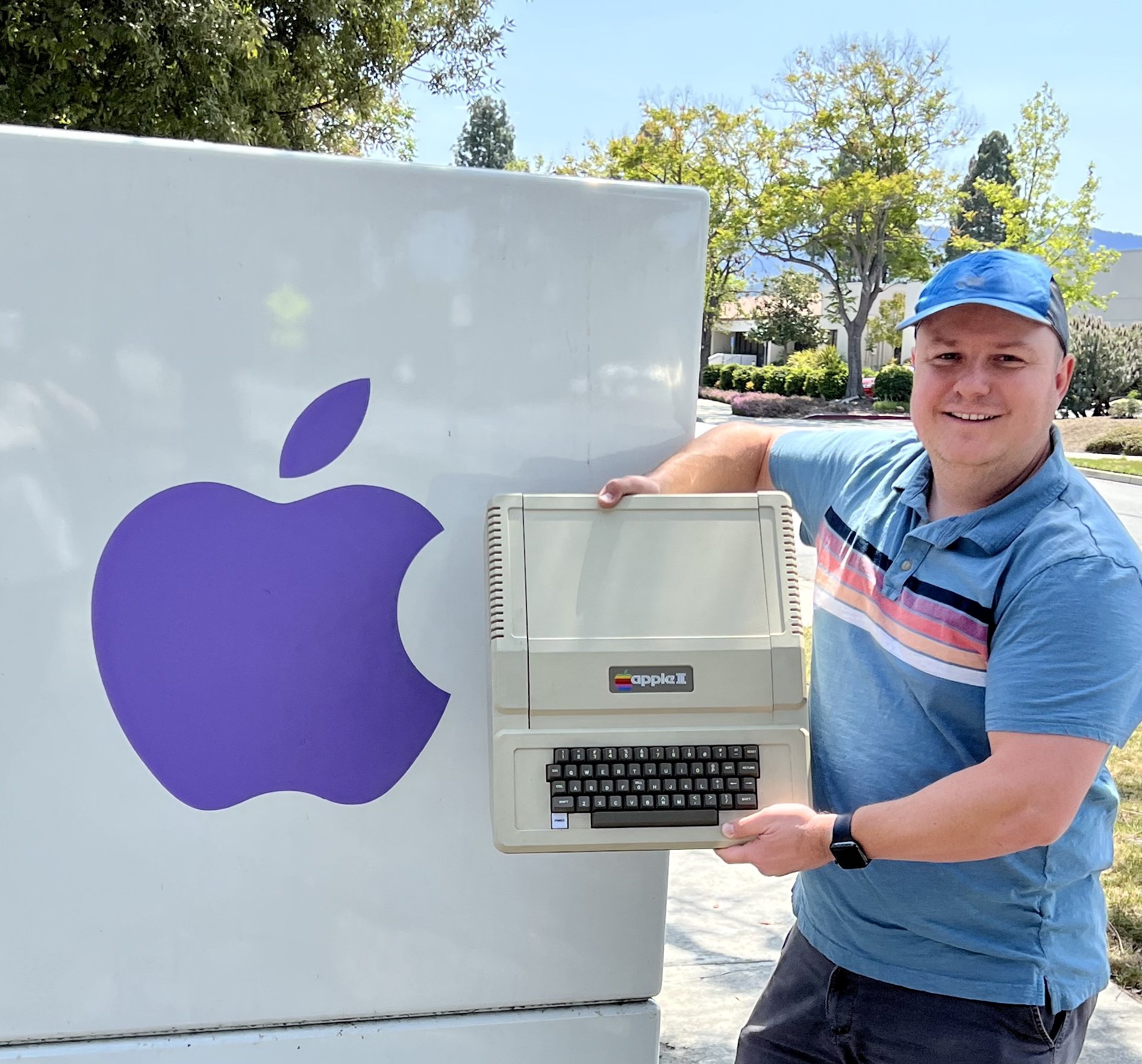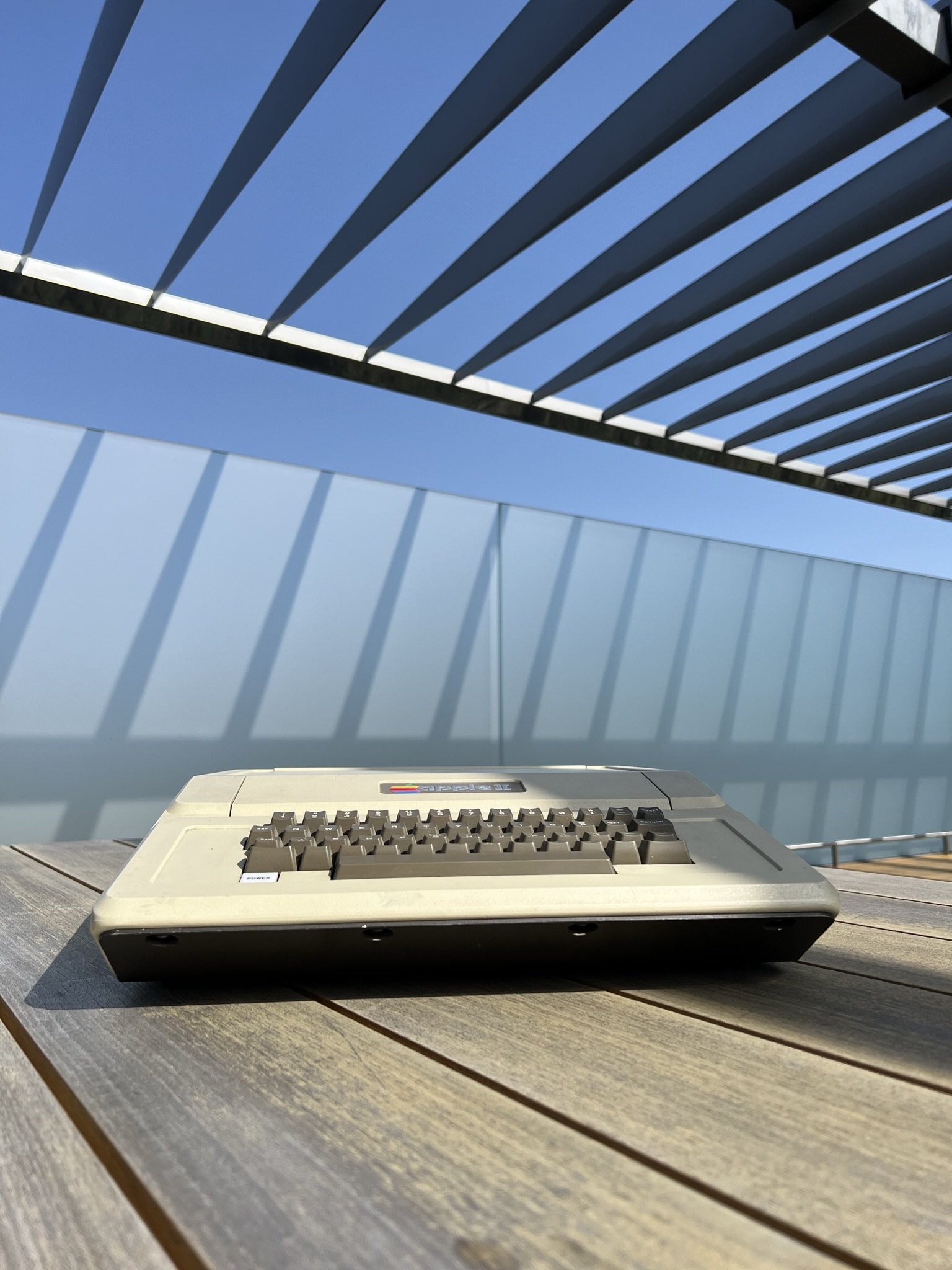The Apple II
I got an alert last night - someone down in Capitola (near Santa Cruz) had made a Craigslist ad for an Apple II computer. That alone is cool but not unheard of around here, being so close to Apple headquarters in Cupertino - machines in the Apple II family still pop up from time to time. However, what immediately caught my eye about this one is that the case badge above the keyboard doesn't indicate that it's one of the later or more common Apple II machines like the Apple II+, or Apple IIe, or Apple IIgs. Those are wonderful and fun machines and I'm very happy to have examples in our collection, but what stood out about this one was that it appeared at first glance to be an original Apple II - i.e., the first fully-assembled computer that Apple sold, which wasn't sold as a bare circuit board with the expectation that the buyer would provide their own case, power supply and keyboard (aka the legendary Apple I). A "plain" Apple II would be an amazing addition to our collection, and would allow future Retro Roadshow events to present nearly the entire line of Apple II-series machines (I do still need to find an Apple IIc...).
I reached out to the seller with a quick inquiry, and when he replied a little while later, he let me know that he'd already heard from nearly a dozen potential buyers, but I'd snuck in just ahead of the rest of them. He was willing to hold the machine overnight, so we made a loose plan to meet up today, and Sarai + Rhyal were happy to take a drive with me. We got up early this morning, piled into the car, put a fun murder mystery audiobook on the stereo ("The Guilty" on Audible, highly recommended!), and enjoyed a beautiful drive down to Capitola.
I'm reasonably familiar with the Apple II series, but I haven't laid eyes on an original Apple II since I was in grade school, so before we left home, I put out some urgent inquiries to various RetroComputing forums and Facebook groups, hoping to get a sense of what specific details I'd want to be on the lookout for. Thankfully, this is a highly-engaged and supportive community, and by the time we arrived, I had a ton of really helpful info I could draw upon while evaluating the machine.
Upon our arrival we were greeted by the seller, Greg. Greg explained that he'd actually worked for Apple back in the early 1990's before diving headfirst into the world of Windows PC's. However, because of his Apple roots, friends and acquaintances often offer him old Apple stuff that turns up. In this case, a friend of a friend's father had recently passed away, leaving behind this Apple II and a few later-model Macintoshes, all of which were given to Greg to "re-home."
While we had a nice conversation, I took a close look at the machine. Based on the pics in the Craigslist ad, I was a little concerned - the badge on the case does read "Apple II" (and not "Apple II+" or "Apple IIe"), but the motherboard inside didn't look to me like the pics of 'plain II' boards I've seen online before, and there seemed to be some differences in the keyboard too. One of the tips I received in response to my urgent help-request before we hit the road was to just look at the label on the underside of the machine - Apple II units would have the machine code "A2S1" (as in, "Apple II Series 1"), while later machines would have codes like "A2S2" and so on. Thankfully, despite some of the quirks of the setup that I noticed in the Craigslist pics, the label on this machine does in fact read "A2S1," even though the motherboard itself was upgraded at some point with ROM chips from a later Apple II+ unit (a common and popular upgrade ~40 years ago).
As I've observed with other retro computers, manufacturing processes in the late 70's and early 80's were nowhere near as tightly locked-down as they are today, and this unit is a great example of this. It's an original Apple II system, but was made at the very end of the 'plain II' production run, so it incorporates a mix of elements that would have been at home in either an original Apple II, or a later Apple II+. Definitely not as valuable as a "non-upgraded" original Apple II from 1977 (one of those machines sold on eBay earlier today for $6,300!), but still a wonderful example of these first-generation machines.
After we concluded our purchase (the seller made us promise to send pics of the machine once we get it restored and operational again!), we started driving towards home. After grabbing some tasty lunch at a Columbian bakery, I had the idea that it might be fun to take the Apple II back to its "ancestral home" - Apple's original corporate headquarters. Apple HQ today is the shockingly-huge, ring-shaped building known as Apple Park, and previously their HQ was the famous building at 1 Infinite Loop in Cupertino. However, in the years before moving to the large campus at 1 Infinite Loop, the company resided in their first purpose-built headquarters, a low-slung affair on Bandley Drive. We circled around for a bit until we found the right spot, double-parked my car, hopped out and snapped a few selfies with the Apple II outside the building which Apple would've been operating out of when it was first sold over 40 years ago.
The Apple II returns to its ancestral home at Apple’s original headquarters on Bandley Drive in Cupertino, CA
From there, we drove a short distance away to the gleaming new Apple Park Visitor Center. The Visitor Center is a fascinating space: part Apple Store, part gift shop, part architectural showcase, part café, and part community center. There was an immediate buzz in the air from the moment we walked in with the Apple II slung under my arm, and before we'd even made it through the entryway, customers and employees were circling around to ask questions about the machine, ask if they could take a photo of it (or in some cases, with it!), and generally soak in the good vibes.
Carrying a circa-1980 Apple II into the Apple Park Visitor Center in 2022
I eventually found an open spot on one of the display tables and carefully set the machine down, and just as we've observed at our Retro Roadshow events, the almost magnetic attraction of a vintage computer in an unexpected setting is powerful. By the time we left a couple hours later, we'd chatted with dozens of employees and customers, all of whom professed their surprise and delight to have one of the foundational Apple computers temporarily displayed alongside the latest-and-greatest hardware the company offers today. One of the conversations that really stands out was with a gentleman named Randy. Randy was personally recruited by Steve Jobs to work on the original Macintosh project, specifically to help design the keyboard on that machine, and has been with Apple for over 40 years now. Speaking with someone who played a key role in creating so many of the products that have enriched my life was just a delight.
The Apple II basking in the sun on the roof of the Apple Park Visitor Center
While I was chatting with various folks about the Apple II, Sarai was doing what she does best: quietly forging connections with various Apple employees, which may lead to some really interesting things for the Retro Roadshow down the line.
This post is already pretty long, so I'll just conclude by saying that my hobby of collecting and restoring vintage computers has always been rooted in my desire to connect with people. Experiences like we had today really validate that the Retro Roadshow project can come back in a post-COVID world and be a continuing source of joy and delight for my family and many other folks too. I can't wait to host our next event!


